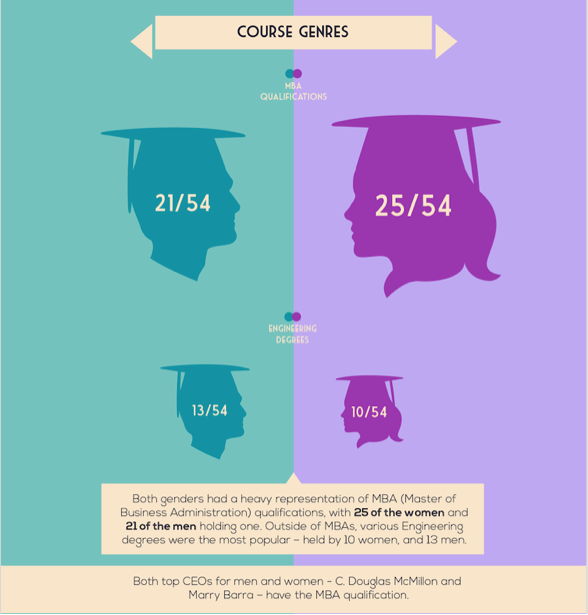The gender gap is an issue that continues to pervade industry, particularly the IT and technology industry. And, although the divide has been bridged to some degree within organisations, the divide remains towards the more senior level.
It is still a prevalent problem, to say the least.
Extensive discussions, both moral and financial, have been given to the effects of gender on high-level positions on an organisation. How do the numbers turn out? How does being a man or woman affect you and your company’s earnings and standing?
>Live Webinar: One month to go: Ensure your journey to GDPR compliance
In order to answer these questions, a new study from recruitment specialists Talentful has looked into 108 Fortune 1000 companies to establish gender trends at senior level. It looks at all the female CEOs in the Fortune 1000 and compares them with an equivalent number of companies with male CEOs from the top of the list.

The most stunning point that stood out from the research was just how few female CEOs there were. In a list of 1000 CEOs, only 54 were women. Despite this small number, it does actually represent a sign of slow improvement.
Business culture is traditionally slow to shift, and CEOs might be in their position for a long time – Warren Buffet has headed Berkshire Hathaway since 1970.
In 2014, however, the number of female CEOs in the top 1000 companies was only 51. Now at 54, this means that either companies run by women are succeeding in the markets, or more women are stepping up into leadership roles. This shows that the idea of a ‘man’s world’ is eroding, albeit slowly.
Core insights
For each CEO, the piece analyses several factors, including the company’s Fortune rank, and the CEO’s total compensation – the total financial gain from the business, made up of both salary and incentives.
Companies with male CEOs rank much higher in the Fortune 1000, by 480 places on average. Of the 54 female CEOs in the Fortune 1000, only 3 of them are in the top 50, and the average ranking for female-run companies is 509. For the men researched, it was 29.
Monetary compensation, however, is one aspect which (perhaps surprisingly, in view of the ranking differences) isn’t quite so male-dominated. Overall, male CEOs receive more company compensation, by nearly $4,439,000.
>See also: Tomorrow’s Tech Leaders Today
The Disney CEO Robert “Bob” Iger receives the most overall, at $43,490,567. The second best-paid overall is a woman– Safra Catz, of Oracle, with $40,943,812.
Some of the other best-compensated positions also belong to women. After Safra Catz, the next two who benefit the most financially are also women: Marissa Mayer, the Yahoo CEO ($35,981,107), and Mary Barra of General Motors, the highest-ranked female CEO in the Fortune 500 at #8, with $28,576,651.
The person with the lowest compensation found throughout the research is the CEO of Alphabet (Google’s parent company), Larry Page, at only $1.
He shares this with several industry leaders, including his co-founder Sergey Brin. However, their stock holdings in Google is sufficient to earn them billions, making the actual compensation symbolic rather than practical.
Qualifications and age
The research includes what qualifications each CEO studied and received prior to becoming taking their current positions. There are two courses which are clearly the most popular across both genders – many men and women have pursued some form of Engineering (Electrical Engineering in turn was the most popular Engineering degree), but there was an even bigger representation of MBAs (Master of Business Administration): 21 male CEOs had one, and 25 of the female CEOs.
>See also: Diversity of thought: breaking down barriers and championing women in IT
There’s a more marked gender difference when it comes to Ivy League graduates – former students of Brown University, Columbia, Cornell, Dartmouth, Harvard, Pennsylvania, Princeton, or Yale. 17 of the male CEOs attended one of the illustrious institutions – compared to only 8 of the female.
Meanwhile, the average age for both genders was 51. Overall, it seems that despite the discrepancies in representation across genders, the type of person who ascends to a CEO role tends to have the same sort of background.

Powerful People
“Women still have limited representation in the Fortune 1000,” said Talentful co-Founder Phil Blaydes, “But it looks like that’s changing, albeit slowly. For all of those studied, their achievements are impressive. It takes a certain sort of character to become a CEO, no matter which gender you are.”
With information on many more CEOs, heading everything from computer companies to fashion firms, energy enterprises to technology trades, there’s much more to see in the Talentful study.
As the report has revealed, most of those CEOs in the Fortune 1000 – whether male or female – have very similar backgrounds in terms of education. So, why is divide at boardroom level so great?
Inherently, a cultural shift needs to be adopted within organisations that reverses gender stereotypes. Those companies that champion diversity are more likely to flourish in an era where innovation is key to survival.
>See also: CIOs still lack diversity and are rooted in STEM degrees
Events like Information Age’s Women in IT Awards, the largest event in the world celebrating women in IT, and our female only career’s fair – Tomorrow’s Tech Leader’s Today – are vital to help break the stigma surrounding women in the technology industry, indeed all industries.
It is also necessary for those men and women who are in senior positions to address the issue by inspiring future professionals to pursue a career in their respective industries and give them the belief to strive for the highest position possible.







